


WHAT IS A DRUM 'FILL' ?
A Drum 'Fill' is a short ROLL-BURST any drummer may
inject into a song to fill up dead-spots within the music. We often add fills between verses
or phrases of a song. Fills tend to add excitement, emphasis and extra feeling to the music
when done in tasteful and purposeful ways. Well executed fills should compliment the music
rather than distract from it. They tend to be the drummer's moment to shine and sometimes our fills
help garner a little momentary (audience) attention to the more unique rhythms within a song.
Great session drummers are the drummers who know to save their fills for precise (empty) moments within the music. When they do let go with a fill idea, they try to cause it to embellish the song in a memorable way while also complimenting the rhythmic ideas of the other musicians within the band or group.
WHAT IS A RUDIMENT?
Drumming Rudiments are purported to be the 'basic building blocks'
of all rhythm. We often use rudiments as 'FILLS', but not all drum-fills are Rudiments.
THE COMMON NOTE-VALUE FILLS
The SIX common note-value (Fill) concepts in this lesson, really ARE the MAJOR BUILDING BLOCKS
of ALL rhythm, (including the rudiments). There are others, but the patterns in this lesson are indisputably the
primary patterns most often used as fills, within today's popular music styles.
CONSIDER THIS VERY BOLD STATEMENT:
With only a few exceptions . . .95% OF ALL 'FILLS' being played on ANY RECORDINGS will be based
on these SIX NOTE-VALUE concepts. Total comprehension of this material will translate into
instant recognition. As we hear various combinations of these note-value fills being played on the
popular recordings we enjoy every day; we'll instinctively know and recognize those NOTE-VALUES by sound
and/or sight. Ultimately, our listening skills develop, while at the same time we'll be sharpening
our rudimental, as well as our reading and writing skills.
This may be one of the most difficult lessons in the course, for beginners. Though this appears (and is counted) as just one lesson, in reality it is six or more lessons, wrapped into one lesson. I feel that students should see the total big picture as they study these. If this lesson was separated, (with each fill-type having its own web page), I worry that the BIG PICTURE effect might be lost. This is our tool-box. We're seeing all the most important tools at one time.
As a teacher I usually devote 6 to 8 weeks of study when teaching this material to average beginning students. Don't allow this lesson to discourage or intimidate you. This is all long-term knowledge. Many pro-drummers may play an entire lifetime without fully comprehending what you will learn here. HERE IS THE GOOD NEWS AND WHAT I'VE DISCOVERED as a 62 year career drummer/teacher. All students who jam with recordings and music regularly will eventually learn all this 'naturally'. It's a mathematical inevitability folks! As we listen, imitate, play and have fun at the set, we get ALL THIS by proxy, (eventually). The difference is; some of us may take 25 or 30 years to get it and (even then) we'll only understand the note-values by feel and sound. We may not understand all of them and we may not recognize them visually, as notation. We also may not know them by their technical names. (I was one of those too, for the first 10 to 15 years of my drumming career.) Your next question might be: what does it matter?
The truth is, "Birds of a feather tend to flock together." For example: If a keyboard player,
guitarist or vocalist asks us to play a quarter-triplet fill, coming out of the chorus of a song and we play it without questions, it means we will
rank more favorably with that player. Educated musicians prefer to work with other educated musicians who speak the same lingo. Later, as
that great player moves into a better, more successful band (with higher pay), they will often pull us into that band with them . . . because of
the communication factor. Knowledgeable players always seek the most knowledgeable drummer. It's our proof that knowledge really is power.
A little studious effort right now can implant all this in the mind in a much, much shorter time. Those who apply their studious-minds at this earliest stage will gain a tremendous advantage over all their competition. They'll usually end-up on top, in the competitive struggle for the best gigs and most money. If knowledge is power; THIS LESSON . . . is that knowledge!
Make your own judgements here. Advanced students may whiz through all this in a day or two. Beginners may need several weeks to fully absorb it. Do not skimp! Do not get impatient or lazy here. By devoting a little extra time and practice, you'll be climbing many, many steps on the ladder of rhythmic wisdom.This knowledge will pay-off with much greater expertise and finesse, once mastered. Memorize every form of every fill. You will need all this to claim your spot as a 'preferred and most respected' drummer. It is vital knowledge and may be more vital than it appears at first glance.
Notice the additional numbers off to the right of each note-value fill-type. It helps to remember these fills as number-patterns. I'll explain all that in an upcoming paragraph.
WHAT ARE THE SIX 'NOTE-VALUE', FILL TYPES? * Optional, for later study . . .
(7. and 8.) 32nd-note triplets (24 + 24) and 64th-notes (32 +32).
THE NUMBERS ARE IMPORTANT . . .
Look at the numbers, off to the right of each note-value.
Visualize the meanings of those number patterns . . .
It's a MATH thing . . . See and remember the numbers as you practice. Learn to think of the fills as numbers, rather than by their names. They will 'feel' nearly the same, any time we use them. The numbers will always be relative though the note-value 'names' may change, depending on the tempos and beat patterns in use.
To explain this a little better, let's look especially at the fill pattern you may already know best, the 16th (single stroke) fill. Notice the numbers are 8 + 8.
What does this mean? It means that each repetition of the roll will contain 8 notes per half measure, or 16 notes per whole-measure of 4/4.NOTE: Half-measure 'fills' are the easiest to learn. Once the half-measure fills have been mastered . . . it becomes quite easy to extend any fill to any length, by doubling, tripling or quadrupling the original (half-measure) idea.
![]()
![]()
So . . . There is really only one rule! Stay in-time with the beat flow of the music and keep it rock-solid steady.
In other words; if you are in mid-fill in the middle of a song and realize that you are about to come-out of the fill incorrectly: simply STOP and WAIT for the next downbeat, before resuming the beat pattern. It works every time! Though your fill many not be what you were intending, it will never be (technically) wrong or incorrect, so long as you always . . . remain IN-TIME with the music.
![]()
![]()
![]() THE CLASSIC NOTE-VALUE FILLS:
THE CLASSIC NOTE-VALUE FILLS:
We're starting at the beginning here, but it 'may' be good to
jump down and study the 16th-note (8+8) fill first, since you may already know that
one. It's the most over-used fill in modern pop styles. Nearly every
drummer learns it first.
The sound and video files are VERY IMPORTANT! Listen to each midi file several times while visualizing the math or numerical concept of each note-value, fill type!
NOTE-VALUE FILL TYPE #1 -
QUARTER-NOTE TRIPLETS:
If we want to play Quarter Triplets . . . we'll need
to play 3 + 3 notes per measure, VERY SLOWLY. . . while maintaining a constant
tempo on the bass drum (right foot.) The bass should remain steady as we execute
this fill, moving from beat to fill and then back to the beat.
Quarter triplets are so slow, they can easily be played with one hand by anyone, (no matter what level). The really hard part is keeping the bass steady as we evenly spread 3 notes across the same time-frame where 4, 6, 8, 12, 16 or 24 notes may be played in the later (more complex) rolls.
I think 4th triplets sound better when played as two simultaneous notes with both the right and left hands. I've written them that way here. You decide. The rhythm pattern is the important thing. It doesn't matter if we use one-hand or both.
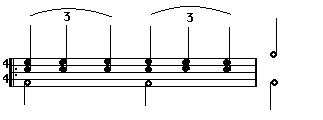
Now try adding 4th (quarter) triplets to the 8th rock beat.

Video: For almost all handhelds and other browsers.
I like to play simultaneous 4th triplets on both the a tom tom and the snare, though it isn't totally necessary. Play them anywhere you wish, with either (or both) hands.
NOTE-VALUE FILL TYPE #2 - 8TH NOTES:
These are easy too . . . Do these with one hand or as simultaneous notes with both! Again, it's your choice.
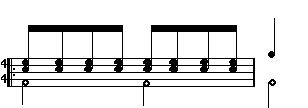
We are already playing 8th-notes on the hi-hat as we are playing the 8th-note rock beat. This fill is that same note-value. Start with the fill, go into the beat, then cycle it a few times (from beat to fill and back to the beat) without stopping. You'll notice that the fill is the exact same rhythm that you have been playing with the right-hand on the hi-hat in the 8th rock beat. 8th notes are 8th notes, whether we play them on the hi-hat or whether they are played as a fill on the snare or toms.
NOTICE THAT THIS FILL IS BASED ON 4+4 or 8 NOTES TO THE MEASURE. The notes are spaced into the SAME TIME FRAME as when we played 3+3 (quarter triplets) earlier. That means this fill will sound and feel a little faster than the previous fill, because there are more notes within the same time frame.

![]() Listen, memorize and mimic the sound . . .
Listen, memorize and mimic the sound . . .
![]() VIDEO: Click here to 'Play', see, and hear the 8th-note fill with the 8th-note rock beat, (.wmv version for IE w/Win Media Player.)
VIDEO: Click here to 'Play', see, and hear the 8th-note fill with the 8th-note rock beat, (.wmv version for IE w/Win Media Player.)
Video: For almost all handhelds and other browsers.
![]()
![]()
NOTE-VALUE FILL TYPE #3 - 8TH NOTE TRIPLETS:
You'll probably need both hands when playing this one . . . Practice this repeatedly. You may hear this fill type most often with songs that use dancebeat #4 (Swing/Shuffle), but it may be used with any beat pattern. REMEMBER!
The bass-drum tempo must remain at EXACTLY the same tempo for EACH of these NOTE-VALUE fills.
If the tempo of your BEAT changes . . . so will the speed of ALL these fills. The bass-drum tempo will bind everything together.
Here is a half-measure 8th triplet fill. You may return directly to the beat after one rep of the fill or you may play two or more reps as shown in the example immediately following this one.
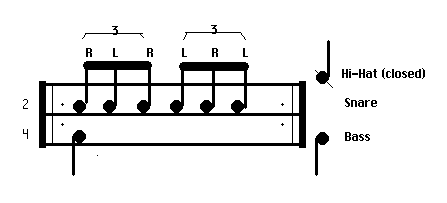
![]() Many students have trouble
REMEMBERING this sound. Listen to it MANY times.
Many students have trouble
REMEMBERING this sound. Listen to it MANY times.
Focus on that bass drum . . . keep it steady . . . repeat the roll until it flows well . . . then go INTO the beat . . .

![]() Listen and BURN it into your memory.
Listen and BURN it into your memory.
Cycle back and forth between the beat and roll until it's easy to do. KEEP THAT BASS TEMPO STEADY.
We're spreading these six notes over the SAME time-frame where 3 + 3 and 4 + 4 were placed earlier.
![]() VIDEO: Click here to 'Play', see, and hear the 8TH TRIPLET FILL WITH THE 8TH ROCK BEAT, (.wmv w/IE).
VIDEO: Click here to 'Play', see, and hear the 8TH TRIPLET FILL WITH THE 8TH ROCK BEAT, (.wmv w/IE).
Video: For almost all handhelds and other browsers.
![]()
![]()
NOTE-VALUE FILL TYPE #4 -
16TH-NOTE, SINGLES DOUBLES OR PARADIDDLES . . .
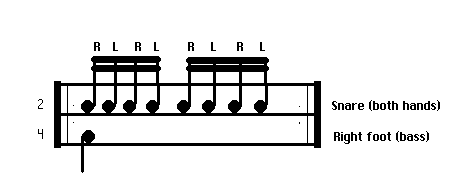
Play a steady stream of 8 + 8. You'll be playing a BASS DRUM (right foot) on the first of every 8 notes. Or, 8 + 8 + 8 + 8 indefinitely.
THE BASS DRUM IS CRUCIAL HERE. DON'T LEAVE IT
OUT. Repeat, repeat, repeat . . . playing the bass along with
the 1st note in every group.
Once you have the roll flowing . . . BREAK OUT OF THE ROLL
and go into a Basic 8th Rock beat . . . without changing the
tempo (speed) of the bass.

NOTE: The Paradiddle (RLRR LRLL) stroke pattern may be used above if you prefer.
Video: For almost all handhelds and other browsers.
The bass should ALWAYS remain constant!
(I know I'm sounding like a broken record . . . but it's SO important.)
You'll come out of the roll . . . and return to the hi-hat (and the beat) on any bass drum note. Continue to cycle from the roll (fill) into the beat and back until it feels easy and natural.
LATER . . .We may play ANY of these fills . . . ANYWHERE in a song that we choose . . . and our fills (or fill combinations) may be ANY LENGTH we choose. We'll always know to resume the beat on a bass drum note. The timing is consistently maintained as right-foot learns to HOLD the count.
![]()
![]()
NOTE-VALUE FILL TYPE #5 - 16TH TRIPLETS:
We are all ONLY human! The tempo of our beat must be REASONABLY SLOW here or we may not be able to keep up. Limit this fill to slower tempos for awhile, until the super-human ability develops. It'll come with enough practice! Most students will need 4 to 5 hours of eventual practice on this one, before maximum speed will result. :>)
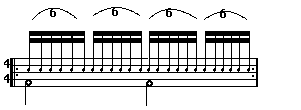
(Play 'R L R L R L', for each group of six notes.)
Imagine cramming 12 + 12 notes (16th triplets) into the SAME time-frame where we just played 6 + 6 (8th triplets) above. If you can do it while maintaining that constant bass tempo . . . you'll be playing 16th triplets.
It's a VERY impressive fill or roll! It'll turn heads every time it's used . . . even in moderate tempos. But that kind of speed will require considerable practice. Some of you may have your work cut-out for you here, but . . . I'll promise this one thing:
"Every hour devoted to this roll will improve your over-all coordination and speed by a factor of 3".
Yes! I'm saying you will become 3 times the drummer you are now . . . with one hour of dull, boring practice on this 12 + 12 (16th triplet) roll!
Watch a great HBO movie as you repeat this 12 + 12 (16th triplet roll), endlessly. It will pay-off BIG . . . and you'll also have a super excuse for enjoying a good movie. Boredom is a killer. You can occupy your great mind with an entertaining movie as you repeat, repeat, repeat this.

(Double groups of 6 with only one bass)
Video: For almost all handhelds and other browsers.
![]()
![]()
NOTE-VALUE FILL TYPE #6 - 32ND PRESS ROLL:
You'll need sticks for this . . . preferably on a real snare drum. This fill is usually MUCH easier to learn than the 16th triplet fill . . . because we'll use a 'trick' to create the illusion of speed. By learning to 'crush' our notes . . . we'll actually be playing twice as many notes in the same relative time frame by cheating or 'crushing' . . . in order to get two notes for one . . .
Here we'll simply play the 8 + 8 roll . . . but we'll 'crush' every note. Thus creating two notes for every stroke. We end up with 16 + 16 by using the 'crush' or 'press' trick, making the sticks growl on the drum head.
TO CRUSH A NOTE . . . grip the stick very tightly with the thumb and 1st finger. No other fingers should be touching the sticks . . .
Lay the stick into the head and force it to 'growl', producing a 'brrr' sound. It's a trick! Squeeze the stick TIGHTLY between the thumb and finger as you strike the head. Make it growl!
Now do it with each hand . . . building speed, placing a bass on the first of every 8 strokes . . . just like the 8 + 8 roll . . . but now we are 'growling' EVERY stroke.
This is called a 32nd press or crush roll. It's very useful as a fill with 8th rock or ANY beat.
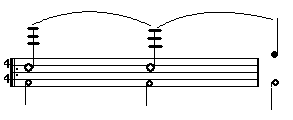
NOTE: Since we're actually playing 32 notes in the above fill, music notation writers tend to make their own job easier by writing and tying one note to another. The three crossbars and ties on the half-notes above are indicating that we'll actually play a 32nd note press or 'crush' roll for the entire length of the measure. Writers may use many conventions to describe this same roll . . . (ie; 2 half-notes with three slashes, 1 whole-note with 3 slashes, etc., etc.)
![]() Listen to it, but use your imagination . . .
Listen to it, but use your imagination . . .
NOTE: I had to cheat a little to achieve a semi 'crush' sound here . . . My midi file maker simply can't do a respectable 'crush'.
Next, drop it into a beat . . . keep cycling from the roll to the beat and back, until you can play it smoothly.

DISCLAIMER: Again, I must apologize for the above midi sound file. It doesn't sound at all like a 'crush' roll should sound. The application I use to make these midi files simply can't manage a 'crushed' sound. What you are hearing is much too 'open'. A crush roll should sound more like you might hear just as a firing squad is about to execute the prisoner in the movies. Use your imagination a little, here. Play 8 notes per bass . . . and 'growl' or 'crush' each stroke. The video I added later, is closer to what we want.
![]() VIDEO: Click here to 'Play', see, and hear the (CRUSHED) 32nd fill with the 8th rock beat. I'd like to do this video over
(after I get a new video camera). It's actually a crush or press roll but it doesn't look or sound as it should on the electronic snare.
Just be sure you are growling, buzzing, pressing and crushing each stroke. It needs to be smoother than I'm doing it here.
This video is for Internet Explorer, using Windows Media Player.
VIDEO: Click here to 'Play', see, and hear the (CRUSHED) 32nd fill with the 8th rock beat. I'd like to do this video over
(after I get a new video camera). It's actually a crush or press roll but it doesn't look or sound as it should on the electronic snare.
Just be sure you are growling, buzzing, pressing and crushing each stroke. It needs to be smoother than I'm doing it here.
This video is for Internet Explorer, using Windows Media Player.
Video: For almost all handhelds and other browsers.
NOW, FOR SOME COOL TIPS AND TRICKS
The rolls will ALWAYS 'feel' the same! Only the BASS DRUM will change as we adapt these fills to the other basic dance beat categories . . .
The NOTE-VALUE NAMES of the fills tend to change too . . . as we play these fills with tempo extremes. That's why the NUMBERS (3+3, 4 +4, etc., etc.) help simplify the entire process . . .
THE FANCY RIBBON . . .
MIX AND MATCH ENDLESSLY . . .
There is almost no end to the ways you can combine all these roll types to produce ENDLESS VARIETY as you play your fills.
Stick with 8th rock 4/4, until you have all these fills adapted to your style. Then, try them with virtually ANY beat on virtually ANY song.
THE 'SECRET' TO ALL THIS DESERVES REPEATING ONE MORE TIME.
KEEP THAT BASS TEMPO ROCK-SOLID-STEADY AT ALL TIMES!
Make your rolls and fills fit the tempo of the beat . . . (not the other
way around.)
WHAT ABOUT RUDIMENTS?
(CLICK HERE to see 'more in-depth rudimental info' and the twenty-six N.A.R.D. rudiments.)Supposedly, (at least, in theory), the rudiments train (or teach) the hands and feet to execute the rhythmic 'ideas' of the mind. I tend to agree and disagree at the same time. Though the rudiments are extremely important, they are also very dry, boring, complex and often impractical.
At the moment, there are nearly 400 documented rudiments on various roll-charts around the World. 95% of those rudiments are made up of THE BASIC 6 ROLLS you've learned in this lesson. Common-sense dictates that almost all student-anxiety and confusion concerning rudiments may be simplified and solved by mastering these SIX NOTE-VALUE fills and rolls, first.
By conquering that steady bass flow, while playing THESE SIX NOTE-VALUE fills . . . you'll discover that MOST (but not all) OF THE RUDIMENTS WILL COME NATURAL.
AFTER ALL . . . the rudiments are nothing more than these SAME NOTE-VALUES . . . combined in various, assorted ways and often while using different stroking patterns. Notice the many varied stroking patterns.
FOR EXAMPLE: 16th or 32nd fills may be played as:Use your imagination as you jam with recordings. LISTEN to the fills and rolls the recorded drummers are playing. Analyze, identify and imitate what you are hearing! Then, invent and create your OWN ideas within the same time frames.
DO NOT BE AFRAID to inject your own imagination and creativity into the music that you play. That's exactly what the recorded drummers are doing.
BUT, be certain you have completely memorized THESE ESSENTIAL NOTE-VALUE fill and roll options, so that you'll be working with a FULL PALETTE of rhythmic color, (tool box) at all times . . .
These fills, once memorized, will add an immense amount of variety to your imaginative playing style.
PARTING THOUGHT . . . If we 'crush' the 16th triplet, (fill #5 , above), we'll theoretically achieve 24 + 24 or 48 notes to the measure. This will increase our basic note-value roll/fill types to a total of seven. It is written as a 32nd triplet when used within the basic 8TH ROCK, SWING OR SHUFFLE 4/4 DANCE BEAT structures.
 Back to the lesson menu:
Back to the lesson menu:
![]()
![]()

![]()
Musical Time - Finite to Infinity:
Finite to Infinity:
Learn to easily jam and play music comfortably within any odd or even time signature. This material isn't currently taught in music-theory classes, yet it is simple enough for grade-school students. Discover more than 18 quintillion unique and different (modern music) song-beat structures.Discover the (lost) 500 year-old enigmatic secrets hidden within the current time-signature system. Seven short mesmerizing and easy-to-follow lessons will lead you quickly and easily towards (musical-time) guru status. You will learn to visualize (read, write or feel) the existence This should lead directly to the e-book.

This very informative little booklet will amaze you with hundreds of valuable tips and insider secrets! HOW TO: Purchase old/used drumsets for pennies and resell them for decent profits.